
Essential Tips for Moving in Florida: Moving Options, Moving Costs, and More
Florida
Florida is well-known as one of the best places to retire in the country. But the state attracts people of all ages for other reasons — including pristine beaches, diverse culture, and a booming aviation industry. In fact, more people moved to Florida in 2022 than to any other state.
But not everyone who moves to the Sunshine State stays. Plenty of folks are moving out of Florida every day, too. And all of this movement? It makes the state the beating heart of the moving industry. That means you’ve got a lot of Florida moving companies to choose from.
| Q: Is it worth relocating to Florida? A: If you’re looking for an active outdoor lifestyle of boating, swimming, surfing, and more, then moving to Florida is absolutely worth it — including the brutal summer months. Because when it’s February and the rest of the country is shivering and shoveling snow, Floridians are enjoying postcard-perfect weather and prepping for spring training. But besides sports and the weather, the state has an abundance of vibrant cities where the arts, dining, and tech innovation are thriving. Check out more on the PODS Blog, such as guides to neighborhoods in cities like Jacksonville and Tampa — just a taste of what the state has to offer. |
So whether you’re moving to Florida to retire in a tropical paradise or moving away for a job, school, or to live in a place with four distinguishable seasons, this guide will help you figure out all the logistics. We’ll cover your moving options and what you can expect to spend during your move. Or you can use these links to jump to specific sections later in the article:
- Florida Moving Costs: Local and In-State Moves
- Moving Costs: Moving Up North From Florida
- Florida Moving Companies: Comparing Moving Options
- Florida Storage
First up, we’ll go over a few pre-move questions, which will help you get focused on your specific moving needs and preferences and narrow down your options.
Try to get a handle on the following questions before you start contacting Florida moving companies for quotes.
Questions to Ask Yourself When Moving in Florida
- How much stuff are you moving (how many bedrooms/boxes/big items)?
- What’s your budget and timing?
- Do you want safe and secure storage?
- How much work are you willing and able to do yourself? Do you have friends or family who can help?
- Are you moving to an area that has narrow streets or parking restrictions?
Now that you’ve got the basic parameters of your Florida move figured out, here’s a quick look at your main moving options and cost estimates to help you get the job done.
What Are Your Florida Moving Options?
Let’s take a closer look at the different types of Florida movers.
- Traditional full-service mover
- Moving container service
- Rental truck company
- A combination of the above
Later, we’ll get into more detail on the good, the bad, and the ugly when it comes to different kinds of Florida movers. But first, let’s talk money.
| Q: What month is best to move in Florida? A: The most popular (and most expensive) months for moving around the U.S. are in the summertime, when kids are out of school and the living is easy. In Florida, however, that’s also the most brutal time of year in terms of heat and humidity. And it’s hurricane season from June 1 through Nov. 30 — an endlessly long slog if the tropics are active and you’re the anxious type. But if summer is the best time for your move, scheduling as close as you can to the start of the season is generally a good decision. The Gulf of Mexico and Atlantic Ocean are not yet bathwater-warm early in the summer, so any tropical storms tend to remain non-lethal. You will likely have to contend with the Sunshine State’s typical afternoon thunderstorms, though, so try to plan for an early-morning load-in to avoid soaking your treasured belongings in a deluge. And wear sunscreen. Because no matter how soaked you get in a seasonal downpour, the Florida summer sun will soon come out to roast you. |
Read on for "Florida Moving Costs: Local and In-State Moves," or click here to go back to the top.
How Much Does a Local Move Cost in Florida?
Not every move will take you to a strange and distant land. Sometimes you’re just moving into some new digs down the street or a bigger house across town. If your Florida moving journey is a local one, here’s a ballpark idea of what you can expect to pay.
Local Florida Moving Costs*
| PODS (includes transport and 1-month storage) | Full-Service Movers (includes transport and loading/unloading) | Rental Truck (plus fuel costs) |
| $475-$795 | $799-$2,321 | $49-$122 |
Of course, every specific location will have its own price. Tampa moving companies may charge a bit more, or a bit less, than Miami moving companies. But they should all be in the same ballpark.
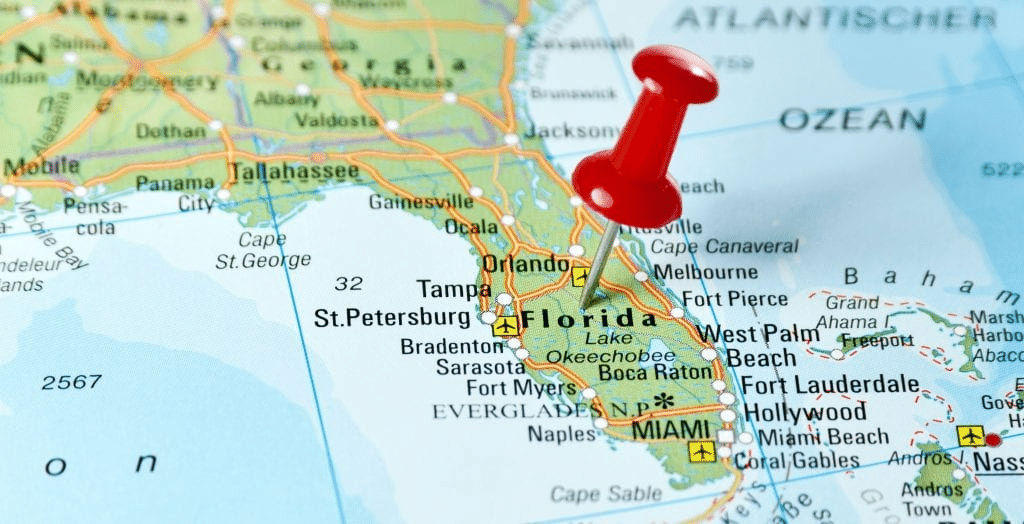
Popular Florida Moving Routes
Florida is the third most populous state in the nation (behind California and Texas), and it has plenty of large, urban centers. That means there are a bunch of popular moves that people make in and out of Florida and between different parts of the Sunshine State.
We’re going to go through the details of a few of these popular routes, beginning with in-state moves.
Moving to Another Florida City
There are several major migration routes for those who are staying in the state. We’ll look at the moving costs and logistics of the following routes:
- Tampa to Orlando (and vice versa)
- Miami to Orlando (and vice versa)
- Jacksonville to Miami (and vice versa)
Let’s dive in.
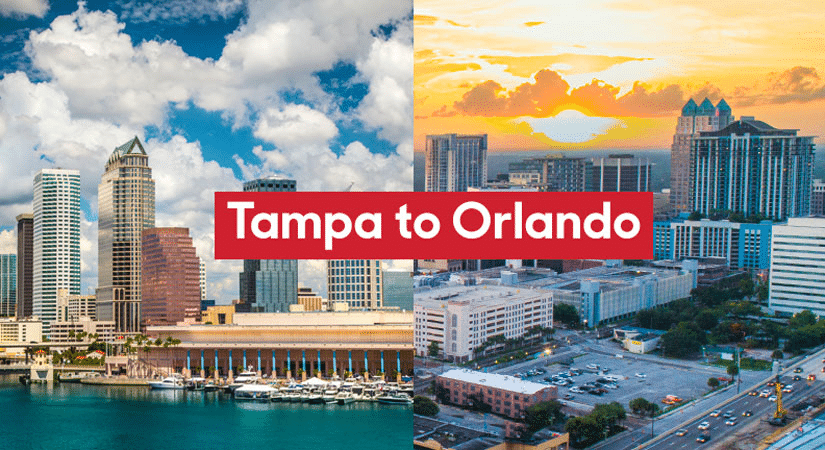
Moving From Tampa to Orlando
Are you looking to trade in the stunning beaches of Tampa Bay for the magic allure of Orlando? Well, there’s more to O-Town than just the theme parks. It boasts the second-largest university in the nation (the University of Central Florida, with more than 70,000 students), a booming real estate market, and, of course, tons of sunshine.
If, on the other hand, you’re heading west to Tampa, you can still get your theme park thrills at Busch Gardens. Plus, you’ll be in the center of a vibrant and diverse culture full of great food, fun nightlife, and plenty of winning sports teams.
But you probably already know why you’re moving, so let’s talk numbers. How much will hiring a Tampa or Orlando moving company cost you?
Cost of Moving From Tampa to Orlando (and Vice Versa)*
| Route | Miles | PODS (includes transport and 1-month storage) | Full-Service Movers (includes transport and loading/unloading) | Rental Truck (plus fuel costs) |
| Tampa to Orlando | 90 | $1,012-$1,625 | $1,598-$3,474 | $142-$217 |
| Orlando to Tampa | 90 | $1,029-$1,644 | $1,598-$3,474 | $142-$217 |
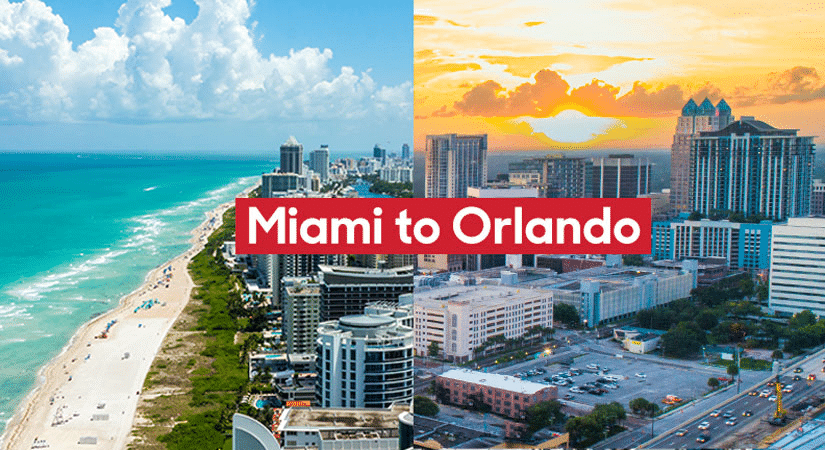
Moving From Miami to Orlando
Whatever your reasons for the move, you’ll find your money goes a lot further in Orlando than Miami, with a 15 percent lower cost of living. If you’re moving the other direction, you’ll find Miami has a more diverse economy, meaning more job opportunities. Plus, the cost to move may be a few hundreds dollars less, as fewer Floridians relocate from Orlando to Miami than the other way around.
Let’s take a look at the estimates for making this move.
Cost of Moving From Miami to Orlando (and Vice Versa)*
| Route | Miles | PODS(includes transport and 1-month storage) | Full-Service Movers(includes transport and loading/unloading) | Rental Truck(plus fuel costs) |
| Miami to Orlando | 240 | $1,413-$2,269 | $1,598-$3,474 | $328-$505 |
| Orlando to Miami | 240 | $1,098-$1,907 | $1,598-$3,474 | $328-$505 |
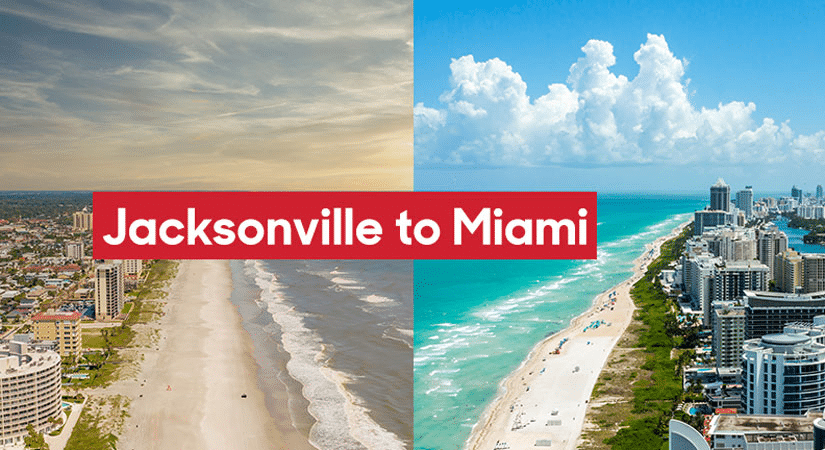
Moving From Jacksonville to Miami
So Jacksonville isn’t hot enough for you? At 350 miles, this route spans nearly the entire length of Florida, and you’ll find quite a difference in temperature and lifestyle as a result. Be prepared to shell out a lot more bucks just to live in Miami, as NerdWallet estimates Miami’s cost of living is 29 percent higher than in Jacksonville. Ouch. But you’ll likely find more job and business opportunities in Miami, and you’ll definitely experience a lot more diversity.
If you’re moving in the opposite direction, you’ll obviously appreciate how much further your dollar will go in Jacksonville.
Now let’s take a look at the cost of moving between Jacksonville and Miami.
Cost of Moving From Jacksonville to Miami (and Vice Versa)*
| Route | Miles | PODS (includes transport and 1-month storage) | Full-Service Movers (includes transport and loading/unloading) | Rental Truck (plus fuel costs) |
| Jacksonville to Miami | 350 | $1,348-$2,247 | $1,830-$5,300 | $328-$505 |
| Miami to Jacksonville | 350 | $2,237-$3,728 | $1,830-$5,300 | $328-$505 |
Read on for "Moving Costs: Moving Up North From Florida," or click here to go back to the top.
Moving Up North From Florida
Florida has everything you could ever want, unless what you want is crisp autumn days, mountains, a white Christmas around a wood burning stove. . . you get the idea. Florida just isn’t the place for some folks. Take a look at some of the most popular routes for those heading north from Florida to help you get an idea of the costs and logistics.
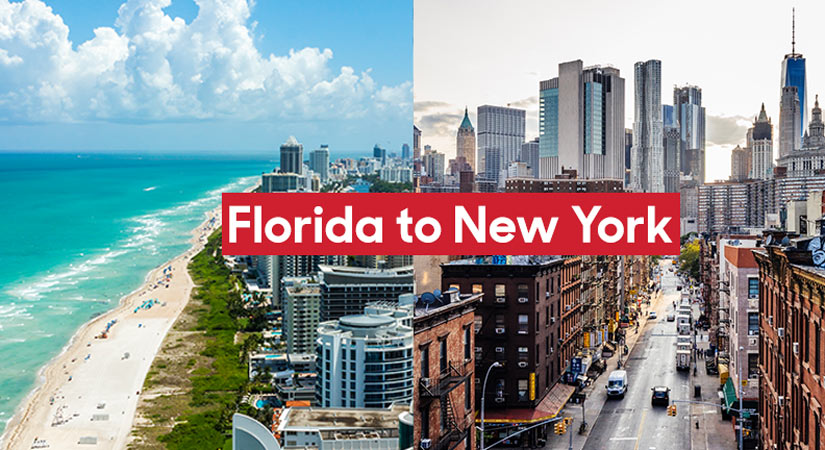
Moving From Florida to New York
If you’re leaving Florida for a change of scenery, then the Northeast — and the New York City area specifically — is a great option. Instead of Disney World, you’ll get Times Square. Instead of warm beaches, you’ll get cool city streets.
Florida is like visiting your sweet grandma who gives you cookies, but NYC is like visiting your cool uncle who’s in a band. Alright, that’s enough with the metaphors, you get the picture. So, how much will moving actually cost you?
Moving to the Big Apple can come with a big price tag. Here’s a look at the average moving costs* for going to NYC from three major Florida cities.
Cost of Moving From Florida to New York*
| Route | Miles | PODS (includes transport and 1-month storage) | Full-Service Movers (includes transport and loading/unloading) | Rental Truck (plus fuel costs) |
| Tampa to NYC | 1,130 | $2,244-$3,441 | $3,020-$7,250 | $1,107-$1,706 |
| Orlando to NYC | 1,080 | $2,134-$3,415 | $3,020-$7,250 | $923-$1,424 |
| Miami to NYC | 1,280 | $2,351-$3,583 | $3,545-$8,050 | $1,107-$1,706 |
Even if you’re moving to a different part of New York — or Connecticut, Massachusetts, New Jersey, or another Northeastern state for that matter — the pricing should be within the same general range. The same goes for leaving south Florida — moving costs from Ft. Lauderdale will be about the same as from Miami. If you’re seeing prices that are significantly higher or lower, be sure to get some additional quotes.
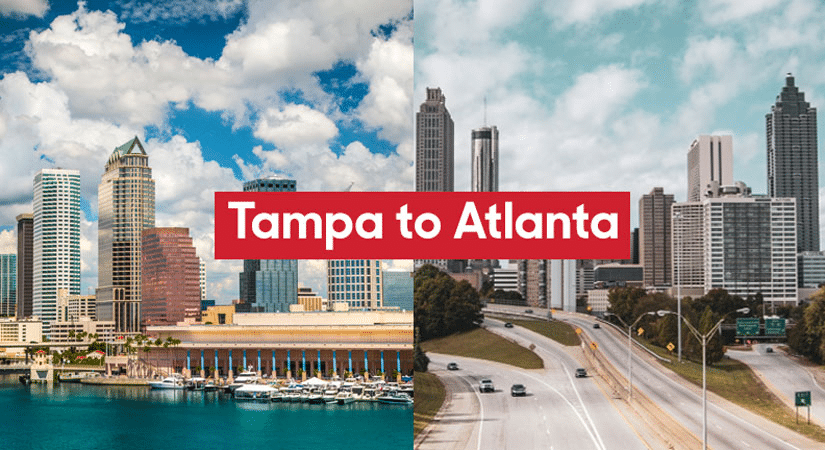
Moving From Tampa to Atlanta
Not everyone who wants to escape Florida wants to leave the realm of southern hospitality.
Here are the numbers on the 460-mile move from Tampa to Atlanta, which is a popular route for those looking to join the city’s prosperous workforce. There are also plenty of beautiful, forest-blanketed mountains nearby — in Georgia, North Carolina, and Tennessee — that are perfect for retirees who want to escape the Florida heat.
Cost of Moving From Tampa to Atlanta (and Vice Versa)*
| Route | Miles | PODS (includes transport and 1-month storage) | Full-Service Movers (includes transport and loading/unloading) | Rental Truck (plus fuel costs) |
| Tampa to Atlanta | 460 | $1,883-$2,824 | $2,450-$6,323 | $630-$972 |
| Atlanta to Tampa | 460 | $2,680-$4,020 | $2,450-$6,323 | $630-$972 |
Even if your move isn’t taking you directly from Tampa to Atlanta, the cost shouldn’t be too far off for other moves to the South, like Jacksonville to Nashville, or Orlando to Birmingham.
Now that we’ve talked about the hard numbers, let’s discuss what the real logistical differences are between full-service movers, moving container companies, and rental trucks.
Read on to compare different Florida moving company options (including their pros and cons), or click here to go back to the top.
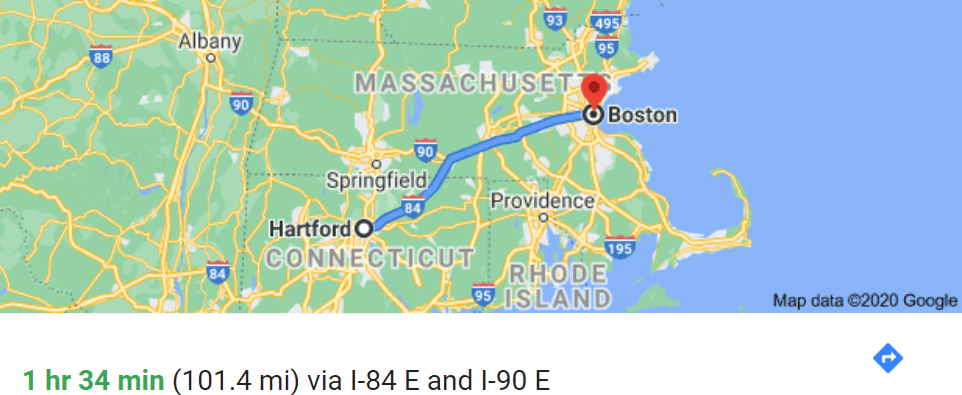
Using a Full-Service Company for Your Move in Florida
You’ve filled up your home with awesome stuff, from big-screen TVs to children’s toys. All those belongings can get overwhelming when it comes time to move. But if you’re willing to hand over a chunk of change, you can get full-service Florida movers to help.
Full-service movers can do everything for you, from packing to loading to driving. You can just sit back and watch Netflix (or you can watch the movers’ every move anxiously to make sure they handle your prized possessions with care).
The biggest catch with full-service movers is, naturally, the price. Going full-service can cost you as much as a decent used car or a European vacation. Yikes. The other issue is there can be a higher damage and loss rate with full-service movers on long-distance routes because they often pile your stuff into a larger truck along with other customers’ belongings — which can mean multiple loading and off-loading instances.
So if you opt to go this route, you’ll want to make sure you’re working with a reputable company. Here are a few steps you can take before hiring a mover.
- Make sure the company has proper licensing and good online reviews.
- Ask about the company’s scheduling and cancellation policies. Do they offer refunds?
- Find out if there are any extra fees for stairs, extra-heavy items, or other factors.
- Figure out if there are any storage units available in case you need to store your stuff while you wait to close on your new house.
- Ask if they use subcontracted labor.
Pros and Cons of Full-Service Movers
| Pros | Cons |
| No heavy lifting | Expensive |
| No driving a huge truck | Schedules can be rigid |
| Less hassle if you choose a good company | Potential for more damage and loss |
| Extra services available | Potential for added fees |
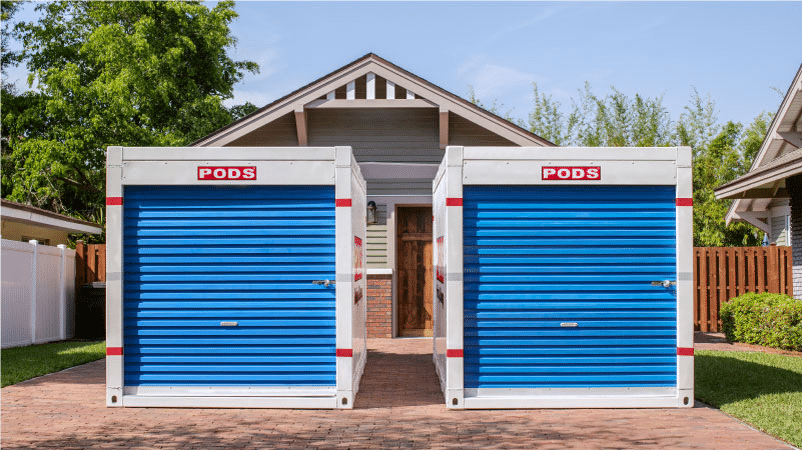
Using PODS Moving Containers
If you’d rather save the money you’d spend on full-service movers for other moving expenses, then you should consider doing a self-move. DIY moves involve a little more work on your part, but they can offer flexibility, autonomy, and a huge cost savings.
One of the simplest ways to go DIY is with a moving container service such as PODS.
Here’s a basic rundown of how PODS works when you’re moving in Florida.
- Your container(s) is delivered to you.
- You can take your time loading (you rent the containers by the month).
- You have the option to hire professional moving help by the hour to help with the heavy lifting.
- PODS picks it up and takes it to a secure storage center or your new place.
- When you’re done unloading, PODS picks up your container.
One thing to consider when you’re moving with PODS is parking: You need a driveway, parking lot, or street parking space for your moving container. If you’re moving to a tight urban setting, like NYC, then you’ll want to double check that there’s sufficient space — or simply take advantage of PODS City Service.
Here’s a quick rundown of the pros and cons of using a moving and storage container for your move to Florida (or out of Florida).
Pros and Cons of Moving and Storage Containers
| Pros | Cons |
| Less expensive than full-service movers | Usually more expensive than rental trucks |
| No driving a huge truck | Parking space required |
| Flexibility to set your own pace | Tight deadlines can be a motivator |
| Option to hire hourly moving help with loading and unloading | You take care of your own loading and unloading |
| Built-in storage options |
Using Rental Trucks
All of the DIY diehards out there will probably want to rent a truck when they’re moving in Florida. With a truck, a few friends, and a little courage, you can do a move for just a couple hundred dollars (depending on how far you’re going).
If you do opt for a rental truck, be sure you’re prepared for a long day (or two). Also decide if you’re up for the challenge of driving a machine that’s twice the size of your SUV. Unlike the PODS option of delivering your stuff directly to your new place, with a rental truck you’re the driver — which means you’ll have to navigate tight city streets and high-speed freeways.
Here’s a recap of the main pros and cons of renting a truck when you’re moving in Florida.
Pros and Cons of Rental Trucks
| Pros | Cons |
| Usually cheapest option for local moves | Subject to high late fees |
| Easy online pricing and reservations | Most stressful option |
| You set the schedule | Driving and parking a huge truck |
| Wide availability | No storage available |
Hybrid Moves
If you can’t decide which type of move is best for you, why not choose more than one? You can combine several options into a hybrid move. Here are a few examples of what hybrid moves can look like:
- Rent a moving container from PODS for items you want to handle yourself or plan to put in storage. Then hire full-service movers to pack and transport the bigger items, like your sofa, tables, and beds.
- Hire labor to help pack and load your moving container. It’s basically like a full-service move at that point but more flexible.
- You can load all of your big items into a single moving container and have it shipped, then transport all of the leftover odds and ends in a small moving truck or van.
You may not be looking forward to handling all the logistics of your move, but it can be a lot easier when you’re doing a move that works for you. That’s the beauty of a hybrid move: You can make it your own!
Read on for "Florida Storage," or click here to go back to the top.
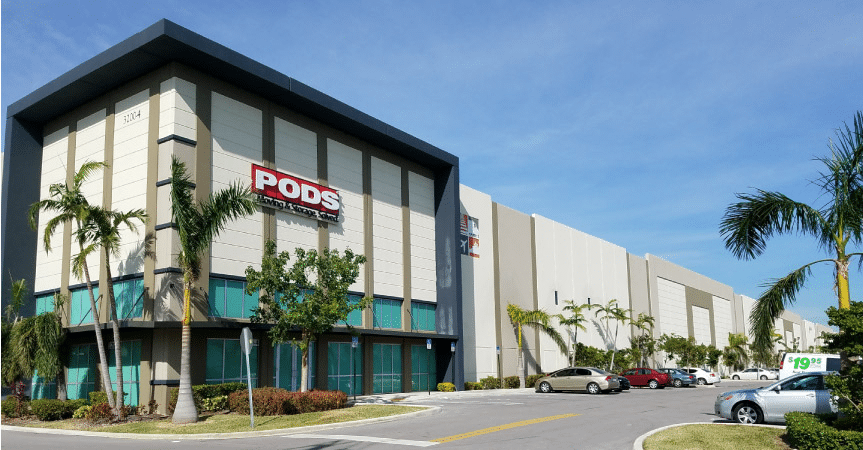
Florida Storage
Your stuff doesn’t have to hold you back from your dreams — whether it’s living on a sailboat, remodeling, or getting the maximum sales price on your home by making room for attractive staging.
Storage can help you free up extra space, downsize, or bridge the gap between moving out of your old place and moving into your new one. So what will Florida storage space cost you?
According to RentCafe, you’ll have to pay an average of $165 per month for a 10’x10’ non-climate-controlled storage unit in Florida. Of course, this number can fluctuate greatly, if you need a different size storage space.
But traditional storage units aren’t the only option if you want somewhere to put your extra stuff. When you move with PODS, for instance, you get a full month of storage included.
The other benefit of storing your stuff with a moving container company like PODS is that you only have to load (and unload) it once, rather than hassling with packing it in a truck and then transferring it to your storage space. Just load the container at your home, send it to a secure PODS Storage Center, and have it delivered back to your place (or to your new home) when you’re ready.
We hope this guide to moving in Florida has helped you figure out how you’ll make your move as smooth and low-stress as possible. Safe travels!
Easton Smith works as a freelance writer and researcher, reviewing technology trends and the moving industry.
Related Articles
Comments
Leave a Comment
Your email address will not be published. Required fields are marked *
